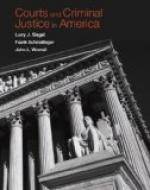For example, the acquittal of Thaw upon the ground of insanity is usually spoken of as an illustration of sentimentality on the part of jurymen, and of their willingness to be swayed by their emotions where a woman is involved. But few clearer cases of insanity have been established in a court of justice. The district attorney’s own experts had pronounced the defendant a hopeless paranoiac; the prosecutor had, at a previous trial, openly declared the same to be his own opinion; and the evidence was convincing. At the time it was rendered, the verdict was accepted as a foregone conclusion. To-day the case is commonly cited as proof of the gullibility of juries and of the impossibility of convicting a rich man of a crime.
There will always be some persons who think that every defendant should be convicted and feel aggrieved if he is turned out by the jury. Yet they entirely forget, in their displeasure at the acquittal of a man whom they instinctively “know” to be guilty, that the jury probably had exactly the same impression, but were obliged under their oaths to acquit because of an insufficiency of evidence.
An excellent illustration of such a case is that of Nan Patterson. She is commonly supposed to have attended, upon the night of her acquittal, a banquet at which one of her lawyers toasted her as “the guilty girl who beat the case.” Whether she was guilty or not, there is a general impression that she murdered Caesar Young. Yet the writer, who was present throughout the trial, felt at the conclusion of the case that there was a fairly reasonable doubt of her guilt. Even so, the jury disagreed, although the case is usually referred to as an acquittal and a monument to the sentimentality of juries.
The acquittal of Roland B. Molineux is also recalled as a case where a man, previously proved guilty, managed to escape. The writer, who was then an assistant district attorney, made a careful study of the evidence at the time, and feels confident that the great majority of the legal profession would agree with him in the opinion that the Court of Appeals had no choice but to reverse the defendant’s first conviction on account of the most prejudicial error committed at the trial, and that the jury who acquitted him upon the second occasion had equally no choice when the case was presented with a proper regard to the rules of evidence and procedure. Indeed, on the second trial the evidence pointed almost as convincingly toward another person as toward the defendant.
I have mentioned the Patterson, Thaw, and Molineux trials because they are cases commonly referred to in support of the general contention that the jury system is a failure. But I am inclined to believe that any single judge, bench of judges, or board of commissioners would have reached the same result as the juries did in these instances.




